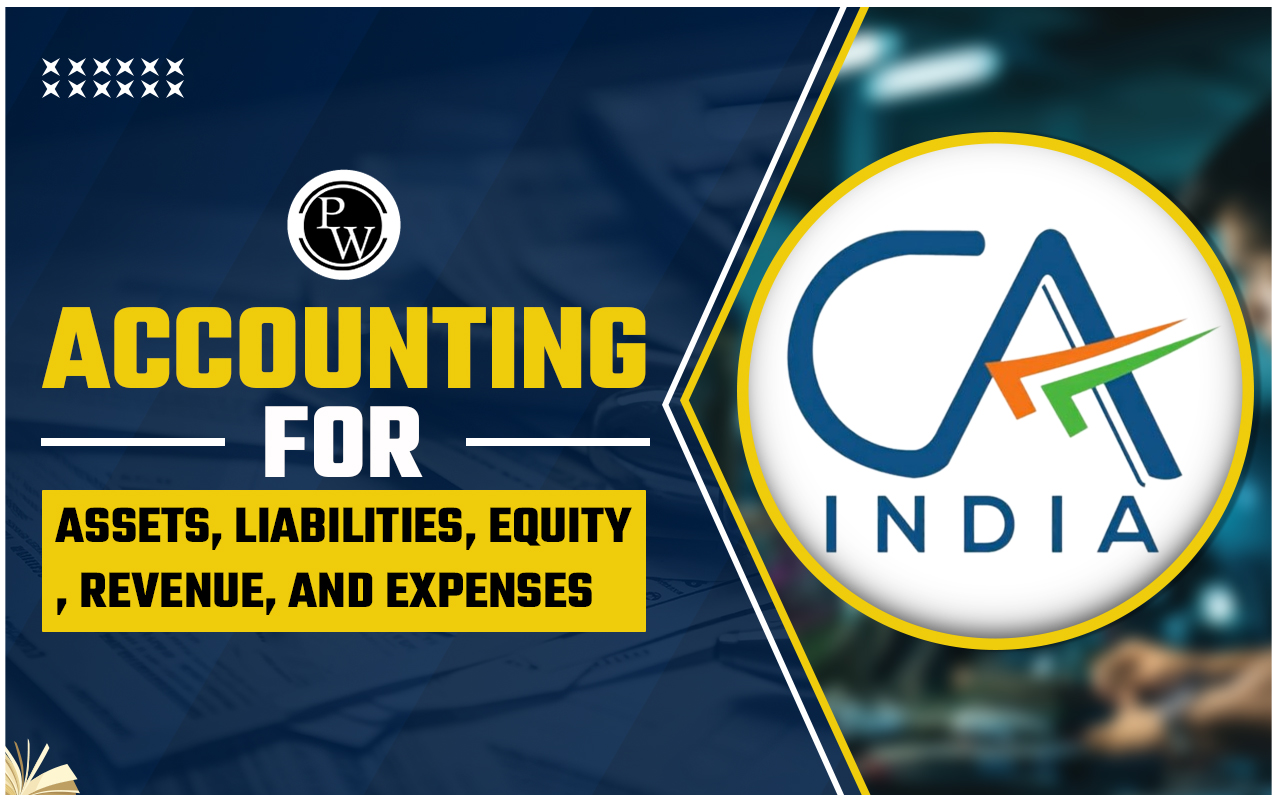

Accounting principles are basic rules that companies follow when they record and share their financial information. These rules make sure that the numbers are accurate and easy to read. Effective accounting is crucial for presenting profits and losses of a business. Thus they play a crucial role in analysing performance and facilitate creating a strategic plan to achieve success.
For effective accounting it is essential to understand basic accounting principles. Additionally, knowing the accounting formula is essential for managing your company's finances. It's the basis of double-entry bookkeeping, ensuring accuracy in every journal entry.
Keep reading to grasp concepts like equity, assets, and liabilities in business, and learn how to use the accounting formula effectively for CA Exams .
What Is Accounting Equation?
The accounting equation shows that everything a company owns (assets) equals everything it owes (liabilities) plus what belongs to its owners (shareholders' equity). This simple equation forms the backbone of double-entry accounting. It keeps the balance sheet in check, making sure debits match credits. Often called the basic accounting equation or balance sheet equation, this concept is a cornerstone of finance.Accounting Types
- Assets: These are things of value that a company owns, which can be either tangible (like cash, computer systems, or patents) or intangible.
- Liabilities: This refers to the money the company owes to others, such as mortgages or vehicle loans.
- Equity: This represents the portion of the total assets that the owners or stockholders of the company fully own and have paid for outright.
- Revenue or Income: This is the money the company earns from selling its products or services, as well as interest and dividends earned from marketable securities.
- Expenses: These are the costs incurred by the company to produce the goods or services it sells, including expenses like office supplies, utilities, and advertising.
Assets
Assets are the valuable possessions owned by a company. They can be classified into two main types: tangible and intangible assets. Tangible assets are physical items such as land, buildings, vehicles, and equipment. In contrast, intangible assets represent value without being physical, including items like patents, contracts, and accounts receivable.
Assets can also be categorized based on their duration and liquidity. Current assets, such as accounts receivable, are expected to be used or sold within a year, while fixed assets, like machinery and buildings, have longer lifespans but are not as easily converted to cash.
Since assets hold value and are utilized over time, they are not expensed all at once. Instead, their value is reduced gradually through a process called depreciation. On a balance sheet, you will find various assets, including cash, inventory, and equipment, which provide a snapshot of what the company owns at a specific point in time.
Liabilities
Liabilities are essentially the financial responsibilities or debts a business owes to others. They come in two main types: current and long-term liabilities. Current liabilities refer to the debts that a company has to settle within a year and mainly include monthly operational expenses like accounts payable and customer deposits. These are usually covered by the money available in the company's checking account or other current assets.Equity
Equity is crucial for business owners because it represents their financial stake in the company - the part of the company's total value that they fully own. This can include assets like buildings and equipment, or simply cash. On a Balance Sheet, you'll find various equity accounts listed, such as Paid in Capital, Capital Stock, Retained Earnings, Owner's Draw, Distributions, and Dividends.Assets, liabilities, and equity are the three main parts of the accounting equation, which is shown on the Balance Sheet like this: Assets = Liabilities + Equity Or, it can be rearranged to highlight equity: Equity = Assets - Liabilities This equation clarifies that owner or shareholder equity is what remains when you subtract liabilities from assets. When liabilities decrease, equity increases, and vice versa. Similarly, when assets increase, equity rises, but if assets decrease, so does equity.
For instance, if I buy a $30,000 vehicle (asset) with a $25,000 loan (liability) and $5,000 in cash (equity), my equity in the asset is $5,000, as per the equation: $30,000 = $25,000 + $5,000, or $5,000 = $30,000 - $25,000. Now, let's focus on three types of Equity accounts that are particularly relevant for many small businesses.
Types of Equity
In business, there are three main types of equity accounts, each with its own purpose. Let's break them down:Contribution (Money Invested): Sometimes, company owners need to put their own money into the business, whether it's for startup costs or to inject cash later on. When this happens, a Capital or Investment account gets credited.
Distribution or Draw (Money Withdrawn): When a business turns a profit, owners often want to take some of that money for themselves. To keep track of this, a Draw or Distribution account is debited. This is the only equity account that receives debits.
Accumulation from Prior Years: This account, usually called Retained Earnings or Owner's Equity, keeps track of the company's net income over time. At the start of each fiscal year, accounting programs typically credit this account with the previous year's net income.
It's worth noting that for most single-owner companies, journal entries are made to "close out" the Contribution and Draw accounts to Retained Earnings at the end of the fiscal year. However, partnerships may choose not to do this to maintain a permanent record of partner activity.| Types of Equity | |||
|---|---|---|---|
| Types of Equity | Sole Proprietor | Partnership | Subchapter S Corporation |
| Money invested | Owner's Investment - or - Capital Contribution | Partner A Capital Contribution, Partner B Capital Contribution, etc. | Paid in Capital - or - Capital Contribution |
| Money withdrawn | Owner's Draw | Partner A Draw, Partner B Draw, etc. | Distribution |
| Cumulative Earnings (less $$ withdrawn) | Owner's Equity - or - Owner's Capital | Partner A Equity, Partner B Equity, etc. | Retained Earnings |
Income or Revenue
Income refers to the money a business makes by selling its products or services, or through interest and dividends on investments. It's also known by other terms like revenue, gross income, turnover, or the "top line." Net income, on the other hand, is what's left after deducting expenses from revenue. It's also called profit, net profit, or the "bottom line." How income is recognized depends on the accounting method. With Accrual basis accounting, revenue is recorded as soon as an invoice is created.However, with Cash basis accounting, revenue isn't recognized until the invoice is actually paid. Income accounts are considered temporary because their balance is reset to zero at the start of each new accounting period, typically a fiscal year. Most accounting software handles this automatically.
Expenses
Expenses are the costs a company incurs regularly to keep its operations running smoothly. These can include things like office supplies, utility bills, rent, entertainment expenses, and travel costs. Similar to revenue accounts, expense accounts are temporary. They gather data for one accounting period and then start fresh at the beginning of the next period. Most accounting software handles this resetting automatically. Unlike liability accounts, which show negative balances on the Balance Sheet, expenses always have positive balances.They're shown on the Income Statement or Profit and Loss Report. Depreciation Expense is a special kind of expense account used for items like vehicles, equipment, and computer systems. Instead of immediately expensing these costly items, they're gradually written off over their expected lifetimes. Another unique account is Accumulated Depreciation, which is a contra-account. It's used to reduce the value of the asset over time. Depreciation calculations can get complex, so it's a good idea to consult with your Accountant for guidance on handling asset depreciation.
Importance of Accounting Equation
To run a successful business, it's crucial to grasp the concepts of equity, assets, and liabilities within the double-entry bookkeeping system. This system ensures that all financial records are accurate and balanced, maintaining equilibrium on balance sheets. Moreover, understanding the accounting equation is key for shareholders, as it reveals the value of their investments during liquidation. Familiarity with generally accepted accounting principles (GAAP) is essential for business leaders, enabling them to steer their operations profitably with a steady cash flow.Accounting FAQs
What is the accounting equation?
What are assets, liabilities, and equity?
What are the types of equity accounts?
What is revenue and how is it recognized?
What are expenses and how are they managed?












